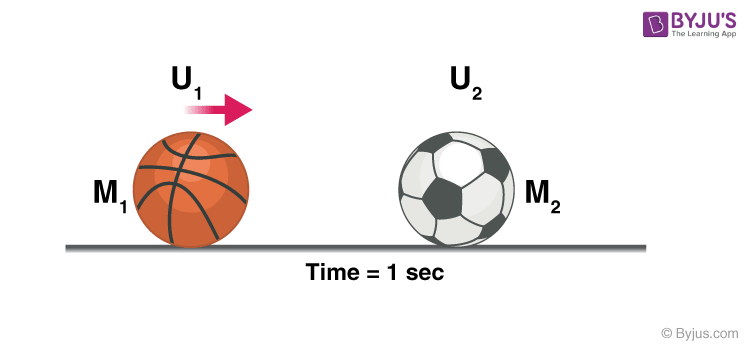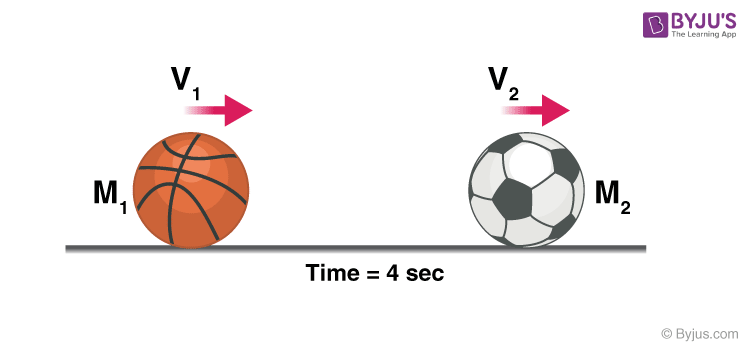We know that momentum is a vector quantity that can be conserved. Momentum is defined as the product of the mass of a particle and its velocity. This article lets us know more about the conservation of momentum, along with its examples.
| Table of Contents: |
What Is Conservation Of Momentum?
Conservation of momentum is a major law of physics which states that the momentum of a system is constant if no external forces are acting on the system. It is embodied in Newton’s First Law or The Law of Inertia.
The law of conservation of momentum is generously confirmed by experiment and can even be mathematically deduced on the reasonable presumption that space is uniform.
- Learn more about Conservation of Momentum in detail by visiting the link.
Watch the video and learn about the laws of motion

Conservation of Linear Momentum:
Conservation of linear momentum is based on Newton’s second law of motion, which states that in an isolated system, the total momentum remains the same. Let’s consider the following example,

Remember: In the above experiment, we did not consider any loss of energy due to friction, heat, etc. and all the collisions were elastic in nature, i.e. there was a total transfer of energy, actual observations may differ.
Let’s consider a case where a football of mass M2 is resting on the ground, and a bowling ball with a comparatively heavier mass of M1 is thrown at the football at a velocity of U1.
When the bowling ball hits the football the energy is transferred and the bowling ball loses some velocity and moves at a new velocity V1, the football moves at velocity V2, why did the football move?

To conserve linear momentum, i.e. the bowling ball had an initial momentum of M1 so as M2 < M1 and the momentum of football should be equal to the momentum lost by the bowling ball according to the law of conservation of momentum, the football had no other option than moving at a velocity V2.

Read More: Conservation of Momentum
Formula:
Mathematically it is given by,
Where,
m1 is mass of the bowling ball
m2 is the mass of the football
u1 and u2 are the initial velocities and v1 and v2 are the final velocities.
Even though the momentum of each particle changes, altogether the momentum of the system remains constant as long as there is no external force acting on it. In a head-to-head car accident, the momentum is transferred from one car to the other, but so much force is applied that the car structure cannot handle it, this is why a car wrecks. If the cars were able to deal with the amount of force, and the collision was elastic they both will move in opposite directions, considering their weights are the same.
In short, momentum is always conserved in any collision, whether it be an elastic or a non-elastic collision, though kinetic energy is not conserved in a non-elastic collision, the kinetic energy is converted into heat energy or potential energy, etc.
Example of Conservation of Momentum
Consider this example of a balloon, the particles of gas move rapidly colliding with each other and the walls of the balloon, even though the particles themselves move faster and slower when they lose or gain momentum when they collide, the total momentum of the system remains the same.

Hence, the balloon doesn’t change in size, if we add external energy by heating it, the balloon should expand because it increases the velocity of the particles and this increases their momentum, in turn, increasing the force exerted by them on the walls of the balloon.
Application of Law of Conservation of Momentum
Having said so the energy of a system is always conserved, one of the best applications of the law of conservation of momentum would be in space travel, there is no medium in space to exert a force on, then how do rockets travel?

Well, they eject matter at a very high speed, so in an isolated system, the momentum should remain constant therefore, the rocket will move in the opposite direction with the same momentum as that of the exhaust.
Watch the video and solve important questions in the chapter Force and Laws of Motion Class 9

Frequently Asked Questions – FAQs
What does the law of conservation of momentum state?
The law of conservation of momentum is based on which law of motion?
What is the real-life example of the law of conservation of momentum?
What is the law of conservation of momentum formula?
m1u1 + m2u2 = m1v1 + m2v2
In the equation, m1 and m2 are masses of the bodies, u1 and u2 are the initial velocities of the body.
v1 and v2 are the final velocities of the bodies.
Does friction affect the conservation of momentum?
Stay tuned with BYJU’S to know more about the law of conservation of momentum, Newton’s Second Law of Motion, and much more.

very good app
This was very helpful
Nice notes thanks